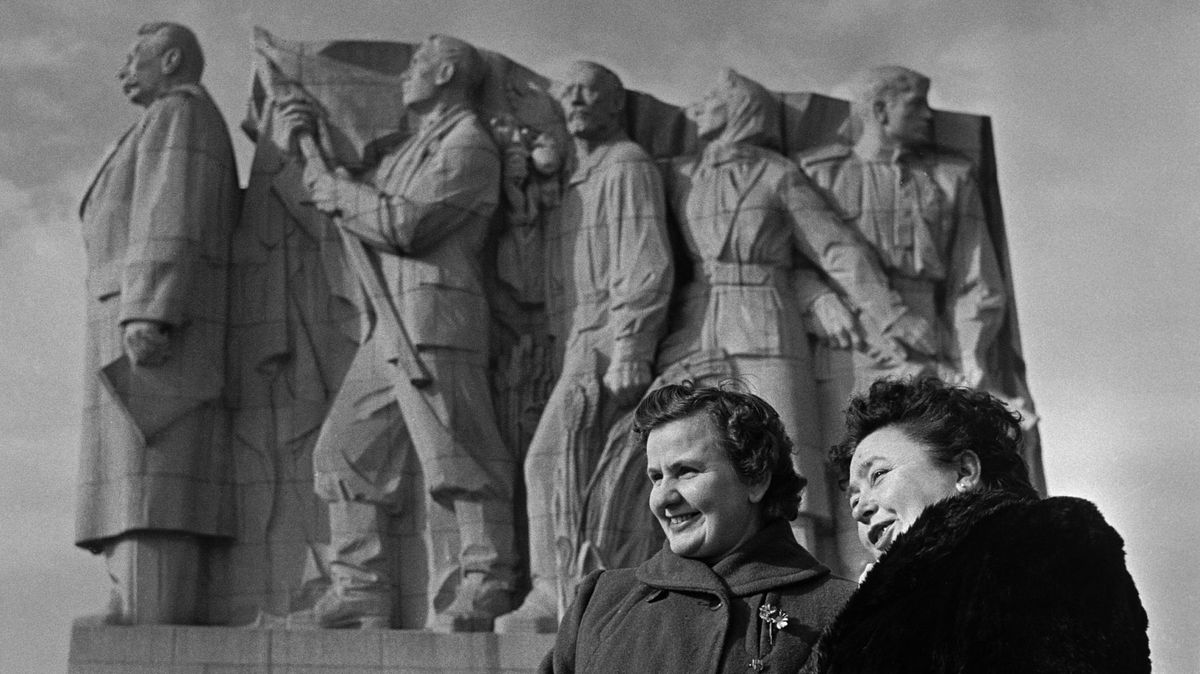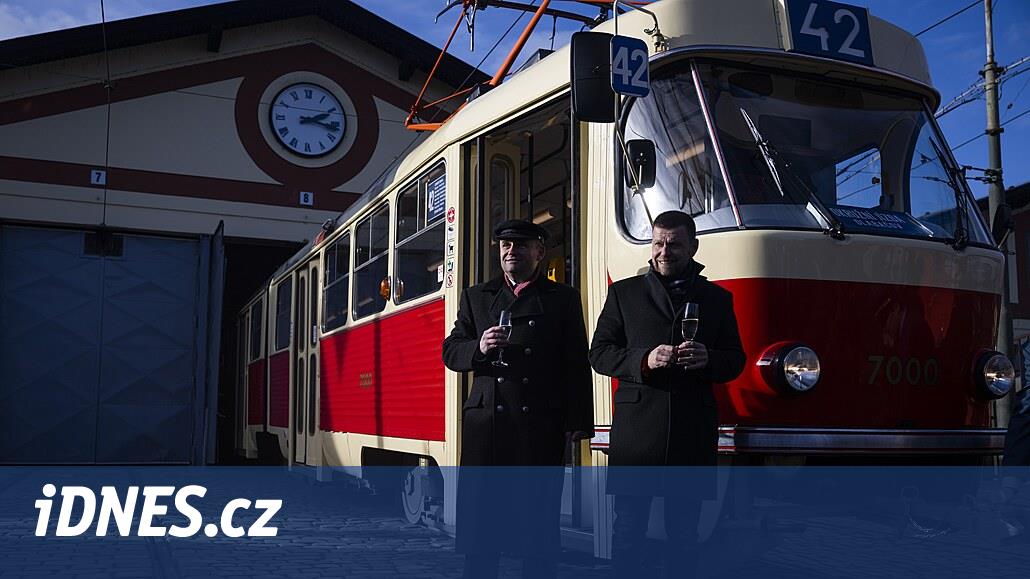The end of the eternal Stalin in Prague: The Communists were afraid of where his head would roll
Stalin’s monument in Prague was to be “forever.” So they carved him out of granite. It was to be a loving monument, a gift to the liberator of Czechoslovakia. He was so huge. Stalin did not live to see the gift. The new Soviet leader Nikita Khrushchev did not arrive for the ceremony. At that time, he was already preparing for a speech about Stalin’s cult of personality.
The magnificent gesture was suddenly more of an embarrassing joke. He towered over Prague for seven years.
What with this? It is said that President Antonín Zápotocký cheerfully verse “we will build Stalin to be seen from Kolín”.
So now the dictator was really monumental. But quickly the feeling began to prevail that it would be better if he hid more.
For a while they tried to pretend that nothing was happening. It didn’t even happen. Monument? What monument?
But they could not stretch Khrushchev’s patience indefinitely. On November 6, 1962, the Stalin monument was demolished in Prague.
A monument to the submissiveness, short-sightedness and incompetence of Czechoslovak communist leaders.
The leader and his people
Communist leaders have had the idea of building a monument to Stalin since the end of World War II. At that time, of course, she looked logical – a liberator.
But it took another four years for the idea to take concrete form. There was a new strong motivation – seventy were approaching Stalin’s agreement.
In 1949, a commission headed by the main party ideologue, Václav Kopecký, decided that the monument would stand on Letná and announced a sculpture competition.
Sixty designs came into the competition and all but one, counting only the figure of Stalin. The commission addressed the only sculptural proposal – the leader is followed by eight figures in two rows. They symbolize the devotion of the representatives of the Czechoslovak and Soviet people. The author was the successful sculptor Otakar Švec, with whom architects Vlasta and Jiří Šturs collaborated.
Despite the authors’ protests, the commission chose granite as the building material. And that, along with the gigantic dimensions of the monument, was a stumbling block. The difficulties of the project are described in detail by the historian Hana Píchová in the study The case of Stalin. And it shows that the members of the government commission were driven primarily by “ideological zeal.” Specific technical, logistical and artistic solutions were often beyond the horizon of their perception or understanding.
Stalin and his eight devoted followers were to have a pedestal 30 meters high, 12 meters wide and 22 meters long. Only Stalin’s shoes were to measure 2 meters. The button on his coat was 60 inches in diameter. The Letna slope could not bear a granite monument of this size. First, it was necessary to concrete the foundation slab and the two-storey cellars built on it, reinforced with reinforced concrete columns.
And granite from quarries in the Liberec region was continuously attached to the construction site: a total of 31,733 granite blocks, some of which weighed more than forty tons. The vehicles are special wagons or modified car tractors. Some bridges and roads on the route had to be widened and reinforced.
And the construction took more than two years longer than planned.
Stalin, meanwhile, died. And he began to suspect even among the Communists that he was a mass murderer rather than a beloved leader and liberator.
The leader and his people II
The “devoted people” underwent tests not only on the construction site. On June 1, 1953, the government declared monetary reform. She had been preparing it in secret since 1952 with the help of Soviet advisers. It was to solve the post-war economic crisis and the transition of the Czechoslovak economy to the model of the Soviet economy. In any case, it robbed masses of people of savings. And brutally reduce their purchasing power.
That was her basic logic. People had money, but they had nothing to buy for it. Following the Soviet model, the state focused on heavy and arms industry, and consumer goods were in short supply. So he took people’s money. And he continued to make the Soviet model.
But even the “devoted people” in the 1950s did not try to do so without a reaction. In many places, people protested and went on strike. The biggest protest took place in Pilsen, where a mass demonstration escalated into an uprising – dissatisfied people occupied the town hall or the radio building. Militias and the army were called in to suppress him.
And even the workers stopped working on one of the most important ideological projects – the construction of the Stalin monument.
At that time, President Zápotocký intervened personally at the construction site. A former stonemason who knew many of his colleagues “from Stalin” well. The stonemasons could talk to him without restraint. AND according to witnesses there were also such words: “Look, Tondo, we’ll talk about those words, you ride in the tattoos, and we sleep here like beasts.”
Zápotocký was eventually believed and work was resumed.
The sources of devotion could no longer be relied upon too much: many of them did not realize that they were working on the mass murderer’s monument. But they knew for sure another thing: His tombstones had robbed them.
Sculptor
Anyway, it was very talented and successful sculptor from the time of the First Republic. He was an artist, bohemian. According to witnesses, he liked the company and especially the company of women he liked.
Why did he create a monumental monument to Stalin? Because he was afraid to refuse when officials invited him to participate in the competition?
Photo from 15. 1.1953: Work on the making of a model of the Stalin monument in the studio of the sculptor Otakar Švec.
Author of the book Granite Stalin Rudolf Cainer to it he says: “When a competition for the design of a statue of JV Stalin was announced in 1949, there were very few designs in the first round. No wonder. The competition required the submission of a model of a statue 30 meters high. In the second round, all the better-known sculptors, including Otakar Švec, had to submit a proposal – under the unspoken threat of inconvenience in the event of non-compliance. “
In the Czech Television program Fateful moments The sculptor Olbram Zoubek evaluates the situation similarly: “Everyone signed up. I didn’t, I was lucky, I was in the war at the time. But if I were in civilian clothes, I probably wouldn’t have the courage not to send a proposal to the competition. “
According to Cainer’s book, a television film was made Monster. He also shows Otakar Švec as a decent man who has verified that he only enters the competition formally, that he cannot win. But he won. And against his will, he became more and more involved with the “monster”.
Otakar Švec sent his proposal to the competition in 1949. And the issues he addressed were current for at least another forty years. How much is it possible to get entangled with the mode? And what boundaries can no longer be crossed? In order to preserve freedom, dignity, inner peace…
It may have been an even more difficult situation for Otakar Švec than for someone one or two generations younger. The shoemaker matured and aged at a completely different time than when he was born and experienced his first successes. He exhibited, traveled the world, was known in Paris, portrayed President Masaryk as a young talented artist, and according to these models, the president’s monument was later erected in Louny… And now?
In any case, he did not live to see the unveiling of the Stalin monument. He committed suicide a few weeks before the party. He was unhappy. His wife was poisoned, she suffered from depression, some friends and colleagues turned away from him due to work on the monument…
Did he take his life for a “monster”?
Blasting
“It was a drama for us – the author killed himself and the investor had the work demolished,” recalls sculptor Josef Klimeš, who worked on the construction site as a student. He adds: “We found it comical that people who did such propaganda around the building demolished the same thing.”
Blasting of the monument to JV Stalin in Prague’s Letná. “We found it comical that people who made such propaganda around the building tore it down.”
Josef Klimeš is also the author of unique photographs. He disguised himself as a construction worker and came close to being shot. The wide area was closed not only for security reasons. Also to make the event possible without witnesses. No documentation. Communist Party assignment: No film, no photography, no mentions in the media.
First, Stalin’s head had to be removed. There was a danger that she could roll down the slope to the bridge during the blast.
Witnesses also claimthat for some party officials, the shooting of Stalin’s head was still a “sacrilege.” “So his head and the heads of the allegorical figures behind him must have been smashed to pieces with jackhammers. And then the layer that depicted the figures was shot. Quite not too vigorous charges to make it fall apart. And as far as I know, the first layer, the statues as such, ended up somewhere in the Vltava riverbed, ” he says Rudolf Cainer.
Three charges in a few weeks were enough. A cloud of dust. And then silence.
The broken granite ended up in places that knew only a narrow circle of initiates, so that the stone would not be misused by anyone for political provocations.
Apart from Josef Klimeš, the whole event was captured by only a few photographers from safe places on the other bank of the Vltava. A few tens of seconds of the secretly shot film also shows the moment “when from that place just dusted“.



